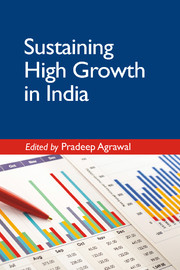Book contents
- Frontmatter
- Contents
- List of Tables
- List of Graphs and Maps
- Preface
- Introduction
- Section 1 Ensuring Macroeconomic Stability for Sustaining High Growth Rates
- Section 2 Promoting Industrial Development for Sustaining High Growth Rates
- 3 Economic Complexity as a Determinant of Industrialization of Countries: The Case of India
- 4 China's Manufacturing Success: Lessons for India
- 5 Sustaining India's Manufacturing Sector Growth in the Face of Increasing Competition from Chinese Imports
- Section 3 The International Economic Issues and Sustaining High Growth
- Section 4 Infrastructure Bottlenecks to Sustaining High Growth
- Section 5 Some Socio-political Issues in Sustaining High Growth
- List of Contributors
- Obituary
- Index
4 - China's Manufacturing Success: Lessons for India
from Section 2 - Promoting Industrial Development for Sustaining High Growth Rates
Published online by Cambridge University Press: 08 February 2018
- Frontmatter
- Contents
- List of Tables
- List of Graphs and Maps
- Preface
- Introduction
- Section 1 Ensuring Macroeconomic Stability for Sustaining High Growth Rates
- Section 2 Promoting Industrial Development for Sustaining High Growth Rates
- 3 Economic Complexity as a Determinant of Industrialization of Countries: The Case of India
- 4 China's Manufacturing Success: Lessons for India
- 5 Sustaining India's Manufacturing Sector Growth in the Face of Increasing Competition from Chinese Imports
- Section 3 The International Economic Issues and Sustaining High Growth
- Section 4 Infrastructure Bottlenecks to Sustaining High Growth
- Section 5 Some Socio-political Issues in Sustaining High Growth
- List of Contributors
- Obituary
- Index
Summary
Introduction
In China, privatization began to gather steam after 1992 and the private sector surpassed the state sector in share of GDP for the first time in the late 1990s. China's leaders saw great potential in large-scale, low-cost manufacturing and economic policy making centred on forming Special Economic Zones (SEZ) and giving foreign firms ‘super-national’ treatment. In addition, China manually pegged its currency to the dollar at an undervalued rate to provide its exports an edge. In short, it put in place a range of strategic policies to enable its ascent in the world economy and became the indomitable manufacturing exporter to the world with a massive chest of foreign exchange in a matter of three decades. China accounted for 22.4 per cent of global manufacturing in 2012, whereas India's share of global manufacturing stood at a little over 2 per cent. The present government in India, however, has unleashed a set of reforms targeted at boosting the manufacturing sector and encouraging exports after years of neglect in what Sanyal (2014) calls ‘India's East Asian dream’. For India to achieve its stated goals of reviving its manufacturing sector and providing jobs to the tens of millions of its unemployed youth, it must design policies targeted at low-cost mass manufacturing and will need massive investment, including major contributions from foreign investors. There are crucial lessons for India in China's success in the manufacturing sector.
This chapter looks at the policies that drove China's manufacturing success and draws lessons for India. It starts by looking at the initial stages of reforms in China, which focused on the agricultural sector, followed by the turnaround in the economy achieved by town and village enterprises. We then look at big bang reforms undertaken by China, mainly in the form of SEZ and Foreign Direct Investment (FDI) policies and to a lesser extent China's exchange rate policy. It also looks at the role of infrastructure development and labour reforms. The objective of this chapter is a comparative analysis of China's and India's manufacturing sector; therefore, it discusses every aspect of the Chinese economic policy relevant to its manufacturing success and compares it to the Indian policy context. The most important comparisons are drawn in policies relating to SEZs, FDI, infrastructure, and labour.
- Type
- Chapter
- Information
- Sustaining High Growth in India , pp. 111 - 146Publisher: Cambridge University PressPrint publication year: 2017



